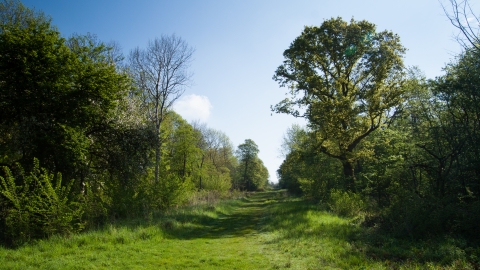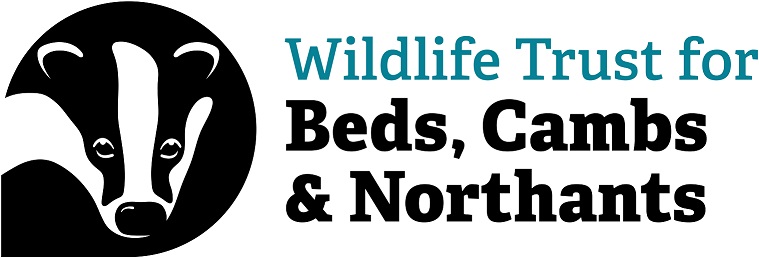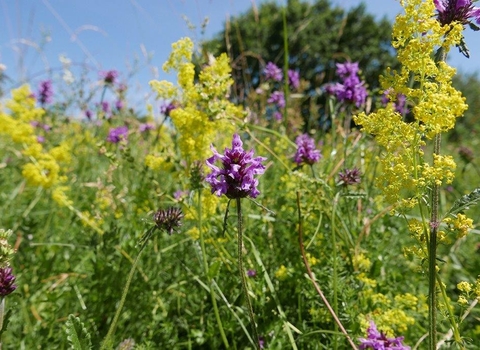PLEASE NOTE: Visit with caution. Machinery on site. Grass cutting underway.

Brampton Wood - Sarah Lambert
Location
Know before you go
Dogs
When to visit
Opening times
Open all the timeBest time to visit
AnytimeAbout the reserve
Brampton Wood is the second largest ancient woodland in Cambridgeshire and is at least 900 years old. The first records date back to the Domesday Book. The trees include aspen, oak, ash, field maple and birch. Some areas are now coppiced and provide a habitat for dormice.
Plants to look out for include primrose, water purslane, wood spurge, common spotted orchid and devil's-bit scabious. Wild pear is a native but uncommon species and two specimens are found on the wood perimeter path with a number of others nearby.
Watch our short film about the reserve
Current Management
We have felled trees beside the rides to create an improved graded edge habitat and providing space for early successional species. Ride edges host high species diversity of plants in sunny locations attracting animals from outlying woodland and grassland areas. Each year we coppice different sections of the wood, creating a variation in age structure throughout the wood. The grassy areas of the ride are maintained by biennial mowing to encourage a high density of wildflowers and sheltering areas.
Habitat restoration in Brampton Wood
As part of the ongoing restoration of the reserve, most of the conifers have been cleared. This clearance work has created open conditions that allow the natural regeneration of native trees and shrubs. Eventually conditions will be ideal for the recolonisation and flourishing of primroses, bluebells and other ancient woodland plants.
Our work is supported by the Forestry Commission and Natural England.
Access (permitted access points and paths)
Brampton Wood SSSI is owned and managed by The Wildlife Trusts for Beds, Cambs & Northants as a nature reserve. Public access to the wood is with the landowner’s permission (Permissive Access) and this can be withdrawn at any point, at the owner’s discretion, for any period of time. We can only allow entry to our nature reserves at designated points. There is no permission given for use of any alternative access points and the Trust reserves the right to amend access locations as it sees fit.
There are no Public Rights of Way (PROW) within the wood, only a few authorised points of entry to the property, which may be closed by the representatives of the landowner in line with planned operations and conservation considerations. Unofficial points of boundary entry will not be permitted and will be closed off to prevent use.
The map below shows the four official entrance points and the sites path and ride network, which will be maintained, modified or withdrawn with no guarantee on year-round suitability, usage or reinstatement.
Additional information
- We have regular work parties at Brampton Wood on the second Sunday of every month. Please consider coming out to lend a hand, make some new friends, and help our wildlife work at this reserve. See the Cambridgeshire work party page for more information.
- Scroll down to see the reserve boundary. Please note the boundary map is for indication purposes only and does not show the Wildlife Trusts definitive land boundary.
FOR ANY MEDIA ENQUIRIES PLEASE CONTACT OUR COMMUNICATIONS TEAM: communicationsteam@wildlifebcn.org or 01954 713500 and ask for comms team.
Species
- Fieldfare
- Hazel dormouse
- Redwing
- Great spotted woodpecker
- Green woodpecker
- Spotted flycatcher
- Song thrush
- Woodcock
- Brimstone
- Gatekeeper
- Green-veined white
- Meadow brown
- Ringlet
- Speckled wood
- White admiral
- Glow-worm
- Bluebell
- Cowslip
- Creeping jenny
- Devil's-bit scabious
- Guelder-rose
- Primrose
- wood anemone
- Wood spurge
- Yellow archangel
- Yellow-rattle

